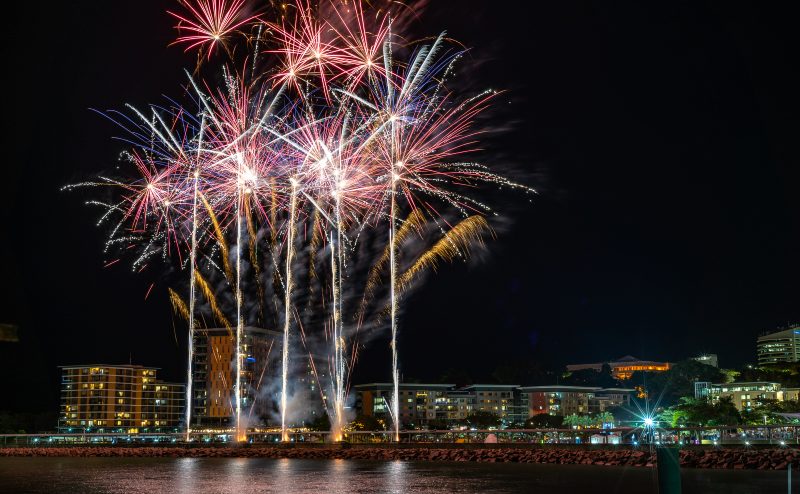WHEN IS THE BEST TIME TO VISIT the Northern Territory?
If you are trying to decide when is the best time to visit the Northern Territory, the main thing to consider is the weather and your tolerance of it! Along with being more comfortable, the best festivals are scheduled to coincide with the best weather. I have visited both in the middle of high season and once in the hot wet season when we are advised to stay away both have their pros and cons. Read on so you know what to expect when you visit.
This page may contain affiliate links. Read our full disclosure policy for more information.
Got a question? Head over to our Australia Travel Tips Facebook Group and ask a local.
There are pros and cons to each time of year and in an ideal world, you would get to experience both. Having braved a wet season in Kakadu and Litchfield, I can highly recommend it – so lush and green. The trade-off is that many roads are closed, so it’s not great for four-wheel driving – but by air, you are in for a treat.
Weather in the Northern Territory
The Northern Territory has two climate zones. The Top End, taking in Darwin and down to Katherine, is tropical. Below this, the climate is semi-arid.
Weather in Australia’s Top End
There are just two seasons in the Top End, the wet and the dry.
- November to April – The wet season sees high humidity and heavy rainfall,
- May to October – The dry season offers lower humidity and cooler temperatures.
The Wet Season
The thing most people find uncomfortable about travelling in Northern Australia is the humidity, which can be as high as 85% in the wet season.
Wet Season temperatures can soar to between 30°C to 38°C (86°F to 100°F) or higher.
January is the wettest month of the year, although heavy rain is not uncommon throughout the season. This makes some road unpassable and some key sites close.
I visited in March one year as the wet was ending, and it was fantastic,lush and green with plenty of action in the waterfalls. There was still some small flooding in parts of Kakadu but we did not miss much and the payback was fewer people around and much lower prices.
The Dry Season
Visiting in the dry season is much more comfortable. Average daytime temperatures range from 20°C to 35°C (68°F to 95°F). Humidity drops to 20-30%,and the rain all but disappears.
As a result, most of the Territory’s big events take place in the dry season, which results in higher prices for accommodation and flights.
Does the Northern Territory experience monsoons or cyclones, and when do they usually occur? The top end can see both monsoons and cyclones during the wet season (November to April). Monsoons bring heavy rainfall and can lead to flooding, while cyclones can bring strong winds and storm surges.
Weather in the Red Centre
The centre of Australia has a semi-arid climate with low annual rainfall.
There are four seasons in the centre, with winter nights getting quite cold, something that catches some people by surprise. Summer brings very little rain and some uncomfortably high midday temperatures. This can reduce the time you have to walk each day, and early starts are the best idea.
Summer (December to February): During summer, the weather is hot and dry, with average daytime temperatures ranging from 35°C to 40°C (95°F to 104°F) or higher. Nights are warm, with temperatures around 20°C to 25°C (68°F to 77°F). Thunderstorms can occasionally occur, bringing brief but often spectacular downpours.
During this time, many walking trails at Uluru are closed from 11am due to the intense heat.
Autumn (March to May): With its milder temperatures, autumn is a much more comfortable time to visit. Daytime temperatures range from 25°C to 30°C (77°F to 86°F), and evenings start to get cooler, with temperatures dropping to around 15°C to 20°C (59°F to 68°F). It is generally dry during this season.
Winter (June to August): The perfect time to visit with daytime temperatures a pleasant 20°C to 25°C (68°F to 77°F), nights become cold, with temperatures dropping to around 5°C to 10°C (41°F to 50°F) or even lower in some areas.
Tip: Be sure to pack warm clothing for the evenings and early mornings. Winter is also considered the peak tourist season, so book early for the best prices.
Spring (September to November): Things start to warm up again. Daytime temperatures gradually rise from 25°C to 30°C (77°F to 86°F) in September to 30°C to 35°C (86°F to 95°F) in November. Nights become milder, ranging from 15°C to 20°C (59°F to 68°F).
Tip: Spring is generally a dry season, but there might be some sporadic rainfall as the weather warms up.
Northern Territory Festivals and Events
When you are looking at the best time to visit the Northern Territory, it’s well worth trying to include some of these unique NT events if you can.
This information may be subject to change, so please check before making plans. I will add updates as they release details. A list of events in Darwin can be found here.
| Date | Festival |
|---|---|
| 7-10 March 2024 | FabAlice Festival – Alice Springs |
| 12-24 April 2024 | Parrtjima–A Festival in Light |
| TBC April 2024 | NT Muster |
| 24-26 May 2024 | Taste of Kakadu |
| 7-10 June 2024 | Barunga Festival – Katherine |
| 7-10 June 2024 | Tatts Finke Desert Race |
| 20-23 June 2024 | Darwin Pride Festival |
| 5-6 July 2024 | Alice Springs Show |
| July 12-21, 2024 | Darwin Fringe Festival |
| TBC August, 2024 | Garma Festival – Arnhem Land |
| TBC 2024 | Darwin Cup |
| 17 August 2024 | Henley on Todd Regatta – Alice Springs |
| 8-25 August 2024 | Darwin Festival |
| 30 August – 1 September 2024 | Red Centre Nats – Alice Springs |
| 12-22 September 2024 | Darwin International Film Festival |
| 25-29 September 2024 | Kakadu Bird Week |
| 1-31 October 2024 | Darwin Internataional Laksa Food Festival |
Northern Territory School and Public Holidays
School holidays see prices go up and availability reduce. If you don’t need to be travelling over holiday periods you can save by avoiding it.
Public Holidays in Northern Territory 2024-2025
| Holiday | 2024 | 2025 |
|---|---|---|
| New Year’s Day | 01 January | 01 January |
| Australia Day | 26 January | 26 January |
| Good Friday | 29 March | 19 March |
| Easter Sat. | 30 March | 20 March |
| Easter Mon. | 01 April | 21 March |
| Anzac Day | 25 April | 25 April |
| May Day | 01 May | 05 May |
| Kings Birthday | 12 June | 09 June |
| Alice Springs Show Day1 | 05 July | 09 July |
| Tennant Creek Show Day1 | 12 July | 11 July |
| Katherine Show Day1 | 19 July | 18 July |
| Darwin Show Day1 | 26 July | 25 July |
| Picnic Day | 05 August | 04 August |
| Christmas Eve | 24 December | 24 December |
| Christmas Day | 25 December | 25 December |
| Boxing Day | 26 December | 26 December |
Source: NT Government March 2024
School Holidays in the Northern Territory 2024-2025
| Period | 2024 | 2025 |
| Autumn break: | 06 April-14 April | 06 April-13 April |
| Winter break: | 22 June- 4 July | 21 June-14 July |
| Spring break: | 21 September – 06 October | 20 September – 05 October |
| Summer break: | 14 December – 27 January 2025 | 13 December – 26 January 2026 |
Need more ideas? Join our Australia Travel Tips group where you can ask questions, stay updated with what’s happening and meet a bunch of friendly local experts ready to share their advice!

